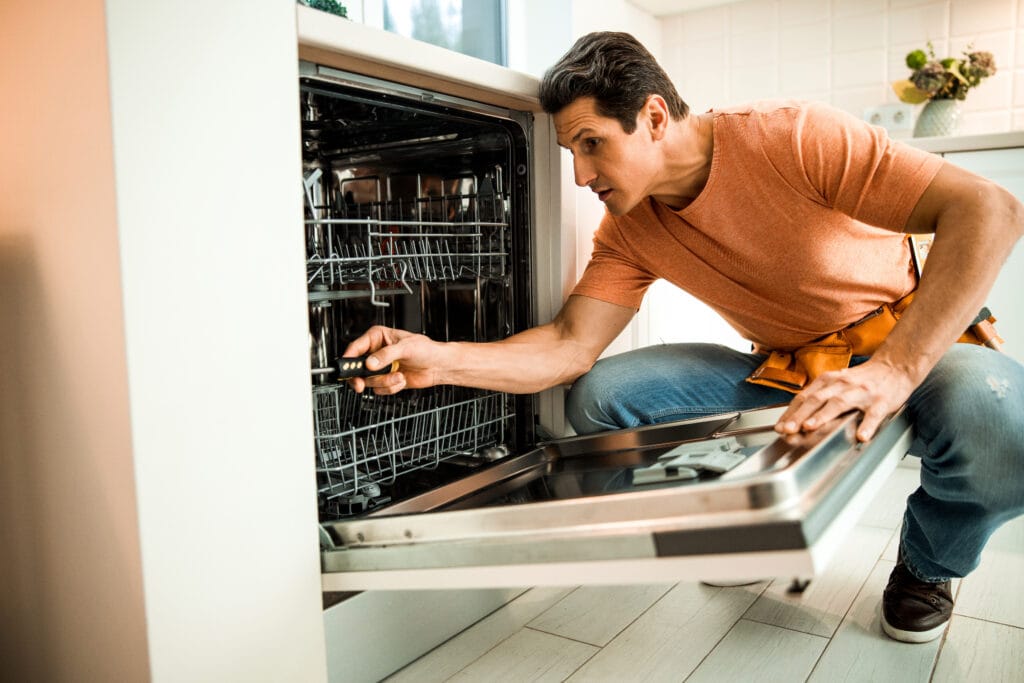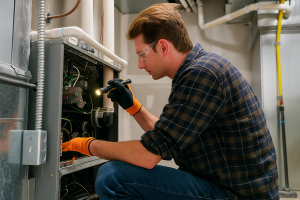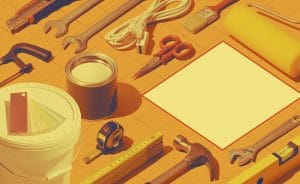Introduction: Empowering Your DIY Dishwasher Repair Journey
Why DIY Dishwasher Repair? Understanding the Benefits
The most immediate benefit of tackling your own dishwasher repairs is financial. With the average professional repair ranging from $100 to $300, the savings from a simple DIY fix can be substantial. Beyond the wallet, there’s a huge sense of accomplishment in solving a problem yourself. You gain a deeper understanding of the appliances you rely on daily, building skills and confidence that extend to other household projects. You also save time by not having to schedule and wait for a technician. In many cases, a simple fix can have your dishwasher back in action in under an hour, getting your kitchen routine back on track without delay. With the dishwasher market continuing to grow, expected to expand from $59.57 billion in 2024 to $62.34 billion in 2025, knowing how to maintain and repair this essential appliance is a more valuable skill than ever.
What This Guide Covers: From Diagnostics to Peak Performance
This guide is designed to be your complete resource for DIY dishwasher repair. We’ll start with the non-negotiable first step: safety. From there, we’ll build your ideal toolkit, ensuring you have everything you need before you begin. We’ll then take a tour of your dishwasher’s anatomy, demystifying the key components and explaining their functions so you know exactly what you’re looking at. The core of the guide is dedicated to diagnosing and fixing the most common issues—from a frustrating leak to dishes that just won’t come clean. We’ll walk you through initial troubleshooting steps, help you decipher error codes, and provide clear, actionable instructions for specific repairs. Finally, we’ll cover preventative maintenance tips to keep your appliance running smoothly for years to come.
Safety First: Essential Precautions for Dishwasher Repair
Before you even think about picking up a screwdriver, it’s crucial to prioritize safety. You’re working with an appliance that combines water and electricity, a potentially dangerous mix. Following these steps isn’t optional—it’s the most important part of any DIY repair.
Disconnecting Power: The Absolute First Step (Circuit Breaker, GFCI outlets)
This is your number one rule: always disconnect the dishwasher from its power source. Do not rely on simply turning it off at the control panel. First, check if the dishwasher is plugged into an outlet under the sink, which may be a Ground Fault Circuit Interrupter (GFCI) outlet. If so, unplug it directly. For most built-in models, the power is hardwired. You’ll need to go to your home’s main electrical panel (circuit breaker box) and find the breaker labeled for the dishwasher or kitchen. Flip it to the “OFF” position. To be absolutely certain the power is off, try to turn the dishwasher on from its control panel. If nothing happens, you’re good to go.
Water Shut-Off: Preventing Leaks and Flooding
The next step is to stop the flow of water to the appliance. Look for a small shut-off valve on the hot water pipe under your kitchen sink. This is usually a small, football-shaped handle or a simple lever. Turn it clockwise until it’s firmly closed. If you can’t find a dedicated valve for the dishwasher, you may need to shut off the main water supply to your house for the duration of the repair. Place a bucket and some old towels under the sink and near the dishwasher to catch any residual water that may drain from the hoses when you disconnect them.
Handling Sharp Edges and Hot Components
Inside a dishwasher, you can find sharp metal edges on racks, spray arm mounts, and internal components. The tub itself can have sharp seams. Move slowly and deliberately when reaching into the appliance. If you’ve just run a cycle, be aware that the heating element (a metal coil at the bottom of the tub) and the water inside can be extremely hot. Allow the dishwasher to cool down completely for at least an hour before starting any work to avoid serious burns.
Wearing Protective Gear: Gloves and Eye Protection
Always wear a pair of heavy-duty work gloves. They will protect your hands from cuts from sharp edges and keep them clean from grime and old food debris. Safety glasses are also a must. They protect your eyes from unexpected splashes of water or cleaning solutions and prevent small screws or debris from falling into them while you’re working underneath the appliance. This simple gear can prevent the most common DIY injuries.
Your Essential DIY Dishwasher Repair Toolkit
You don’t need a professional-grade workshop to handle most dishwasher repairs. A small, well-curated set of tools will see you through the vast majority of common issues. Having these items on hand before you start will make the entire process smoother and more efficient.
Basic Hand Tools: Screwdrivers (Phillips, Flathead), Pliers, Adjustable Wrench
These are the workhorses of your toolkit. You’ll need a set of screwdrivers with various sizes of Phillips and flathead bits; many screws on a dishwasher, especially on the door panel and access panels, will be one of these two types. A pair of slip-joint pliers is great for gripping, while needle-nose pliers are perfect for retrieving dropped screws or manipulating small wires. An adjustable wrench will be your go-to for loosening or tightening the nuts on water line connections.
Diagnostic Tools: Multimeter for Electrical Testing (Wiring, Connections, Switches)
For any issue that might be electrical—like a heating element that won’t heat or a dishwasher that won’t start—a multimeter is an indispensable diagnostic tool. It allows you to test for continuity, which tells you if an electrical path is complete. You can use it to check if components like fuses, thermal cutoffs, door switches, and the heating element itself have failed. It’s a safe way to determine if a part needs replacing before you spend money on it.
Specialty Tools: Torx Bits, Nut Drivers, Hose Clamp Pliers
While not always necessary, these tools can make certain jobs much easier. Many modern dishwashers use Torx screws (star-shaped heads) on their door panels and control panels, so a set of Torx bits is a smart investment. Nut drivers look like screwdrivers but have a socket at the end, making it much easier to remove the small hex-head screws often used to secure access panels and components. If you need to remove a drain hose, a pair of hose clamp pliers will make releasing the spring-loaded clamp a simple, one-handed job.
Cleaning Supplies: Rags, Brushes, Vinegar, Baking Soda (Soapy Water)
Repairs often go hand-in-hand with cleaning. Keep a supply of old rags or paper towels for mopping up water and wiping down parts. A small collection of brushes—like an old toothbrush or a bottle brush—is perfect for scrubbing grime out of the filter, spray arm nozzles, and other tight spaces. For a deep clean, a simple solution of soapy water, white vinegar, or a paste of baking soda can work wonders on built-up residue and hard water deposits.
Personal Protective Equipment: Gloves, Safety Glasses
This is so important it’s worth mentioning again. Your safety gear is a tool. Heavy-duty gloves and safety glasses should be considered a non-negotiable part of your kit for every single repair, no matter how small it seems.
Understanding Your Dishwasher’s Anatomy: Key Components & Their Functions
Before you can fix your dishwasher, it helps to know what you’re looking at. Think of it like a map. By understanding the main components and what they do, you can better diagnose problems and navigate your repair.
Water Inlet Valve: Controlling Water Flow
This is the gatekeeper for water entering your dishwasher. Usually located at the front, bottom-left of the appliance, this electrically controlled valve opens to let hot water from your home’s supply line into the dishwasher at the start of a cycle. If your dishwasher isn’t filling with water, or if it’s overfilling and causing a leak, this valve is a prime suspect. A faulty valve might be clogged with sediment or have a failed electrical solenoid.
Drain Pump & Hoses: Managing Water Drainage (Drain Hose, Kinks, Blockage)
After the wash and rinse cycles, the dirty water needs to go somewhere. That’s the job of the drain pump and drain hose. The pump, a small motor with an impeller, forces water out of the dishwasher tub and into the drain hose. This hose typically connects to your kitchen sink’s drain or a garbage disposal. If you find standing water at the end of a cycle, the issue often lies here. A blockage from food debris in the pump, a kink in the drain hose, or a clog where it connects to the sink plumbing can all prevent proper drainage.
Spray Arms (Upper & Lower): Ensuring Proper Washing & Water Pressure
The spray arms are the components that do the actual cleaning. These rotating arms, one at the bottom and often a second one under the top rack, are full of small holes or nozzles. The circulation pump forces water into the spray arms at high pressure, causing them to spin and spray water all over the dishes. If your dishes are coming out dirty, check the spray arms. The nozzles can easily get clogged with small food particles, preventing water from spraying out effectively. A cracked or warped arm can also disrupt the water pressure and rotation.
Heating Element: For Water Temperature & Drying (Metal Horseshoe-Shaped Heating Element)
Visible at the bottom of the dishwasher tub, the heating element is a metal, often horseshoe-shaped, tube. It has two primary functions: to heat the water to the optimal temperature for cleaning and activating detergent, and to heat the air during the drying cycle to help evaporate water from the dishes. If your dishes are consistently wet after the dry cycle or don’t seem to be getting clean, a failed heating element could be the culprit. You can test its continuity with a multimeter.
Filter System: Trapping Food Particles and Debris (Drain Filter)
The filter system is your dishwasher’s first line of defense against clogs. Located at the bottom of the tub, usually beneath the lower spray arm, this system traps large food particles and debris washed off the dishes. Most modern dishwashers have a removable, multi-part filter that you can twist out for cleaning. A clogged drain filter is one of the most common causes of poor cleaning performance, strange noises, and standing water. Regular cleaning of this component is essential maintenance.
Control Panel & Switches: Operating the Wash Cycle (Micro Switch, Overfill Float Switch)
The control panel is the brain of the appliance, housing the electronic board and buttons that allow you to select a wash cycle. Within the dishwasher, various switches act as sensors. A key example is the door latch switch, a micro switch that tells the control panel the door is securely closed so the cycle can begin. Another is the overfill float switch, a small floating device in the tub that rises with the water level. If the water gets too high, it triggers a switch to shut off the inlet valve, preventing a flood. A failure in any of these components can lead to a dishwasher that won’t start, stop, or fill correctly.
Gaskets & Seals: Preventing Leaks (Door Seal, Gaskets)
A flexible rubber or vinyl gasket, often called the door seal, runs around the perimeter of the dishwasher door or the tub opening. Its job is to create a watertight seal when the door is latched shut. Over time, this seal can become brittle, cracked, or caked with grime, leading to a frustrating leak. There are also smaller gaskets and seals on other components, like the drain pump assembly, that can degrade and cause leaks from underneath the appliance.
Circulation Pump & Motor: Powering Water Distribution
The circulation pump and its motor are the heart of the dishwasher. This powerful component is responsible for taking the water that fills the tub and forcing it up into the spray arms with enough pressure to clean the dishes. It’s a different component from the smaller drain pump. If you hear a loud humming or grinding noise during the wash cycle, but the spray arms aren’t spinning, you may have an issue with the circulation pump, such as a seized motor or a foreign object blocking its impeller.
Initial Troubleshooting: Diagnosing Common Dishwasher Issues
When your dishwasher acts up, don’t immediately assume the worst. Many problems have simple solutions. A methodical approach to troubleshooting can help you pinpoint the issue quickly and avoid unnecessary repairs or expenses.
Checking Power Supply: Is It Plugged In? (Circuit Breaker, GFCI outlets)
It sounds obvious, but you’d be surprised how often it’s the solution. Before anything else, if your dishwasher is completely dead, check the power. If it plugs in under the sink, ensure the cord is firmly seated in the outlet. Press the “Reset” button on the GFCI outlet. If it’s hardwired, go to your circuit breaker box and check if the breaker has tripped. A tripped breaker will be in the middle position; flip it all the way off, then back on to reset it.
Reviewing the User Manual: Model-Specific Information (Troubleshooting Charts, Error Codes)
Your dishwasher’s user manual is an invaluable tool. It was written specifically for your model and contains a wealth of information. Look for a troubleshooting chart, which lists common issues and their potential causes and solutions. This can often guide you directly to the problem. The manual is also the key to understanding the error codes that might be flashing on your control panel. Keep it handy, or if you’ve lost it, a quick search online for your dishwasher’s model number will almost always bring up a digital copy.
Listening for Sounds: Identifying Abnormal Noise
The sounds your dishwasher makes can tell you a lot. A low hum is usually normal, indicating the motor is running. A loud grinding or scraping sound could mean a hard object, like a piece of glass or a fruit pit, has gotten into the chopper blade area or is stuck in the drain pump. A thumping noise might be a spray arm hitting a dish that’s hanging too low. Pay close attention to when the noise occurs during the cycle (filling, washing, draining) to help narrow down the source of the issue.
Visual Inspection: Looking for Visible Signs of Damage, Leaks (Puddle of Water, Cracks, Holes), or Blockages
A careful visual inspection can reveal a lot. Open the door and look inside. Do you see a puddle of water at the bottom? Check the filter for a blockage. Are the spray arm holes clogged with food? Look at the door seal—is it cracked, torn, or dirty? If you have a leak, try to pinpoint its origin. Is the puddle of water directly under the door, or is it coming from underneath the appliance? Use a flashlight to check the water inlet hose and drain hose connections under the sink for any drips, cracks, or holes.
Understanding Error Codes: Deciphering the Control Panel’s Signals
Many modern dishwashers use a system of blinking lights or alphanumeric codes on the control panel to communicate specific issues. A code might indicate a problem with water filling, draining, or heating. This is where your user manual is essential. It will have a section that lists each error code and explains what it means and what steps to take. This feature takes a lot of the guesswork out of diagnostics and is one of the most helpful tools for any DIY repair.
What’s Next?
You’ve successfully journeyed through the essentials of dishwasher repair, from understanding the core principles of safety to identifying the function of every key component. You are now equipped with a diagnostic roadmap, a list of necessary tools, and the knowledge to interpret your appliance’s cries for help, whether it’s a strange noise or a flashing error code. You’ve learned that a puddle on the floor often points to a simple issue with a door seal, and that dirty dishes can be revived by cleaning a clogged filter or spray arm.
Your next step is to take this knowledge and apply it with confidence. The next time your dishwasher falters, don’t reach for the phone to call a technician right away. Instead, come back to this guide. Start with the safety steps—power and water off. Use the troubleshooting section to diagnose the likely cause. Gather your tools and systematically check the components we’ve discussed. Remember that the majority of dishwasher issues are minor fixes that you are fully capable of handling. Regular maintenance, like cleaning the filter and checking the spray arms, will be your best strategy for preventing future problems and extending the life of your appliance, which can typically last between 10 and 15 years with proper care. You’ve got this.








